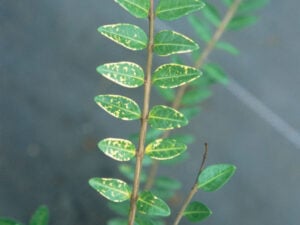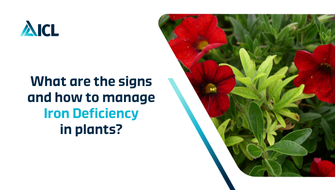Boron deficiency in horticulture refers to a condition in which plants do not receive an adequate supply of the essential micronutrient boron (B).
Boron is a vital element for plant growth and development, and its deficiency can have significant negative impacts on plant health and productivity.
What are the symptoms of Boron Deficiency?
Leaf Symptoms
- Young leaves are often the first to show symptoms. They may exhibit chlorosis (yellowing) and a distorted or wrinkled appearance.
- Brown or necrotic (dead) areas may develop at the leaf tips and margins, leading to dieback.
- In some plants, leaves may become thick and brittle.
Stem and Root Symptoms
- Stunted growth and reduced stem elongation, which can result in a bushy appearance.
- Abnormal swelling or cracking of stems, which is especially noticeable in fruits like apples.
- Root development may be poor, leading to a reduced ability to take up water and nutrients.
Flower and Fruit Symptoms:
- Flower formation may be impaired, leading to poor fruit set.
- Fruits may exhibit deformities, cracking, and corky or discolored areas.
- In some cases, internal fruit disorders like hollow heart in potatoes can occur.

Boron Deficiency in Lonicera
What are the impacts of Boron Deficiency?
- Reduced Crop Yield: Boron is involved in several essential physiological processes, including cell division and carbohydrate metabolism. Its deficiency can lead to reduced fruit or vegetable production and smaller crop yields.
- Poor Fruit Quality: Boron deficiency can result in lower fruit quality, including deformities, cracking, and a decrease in flavor and shelf life.
- Economic Loss: Boron deficiency can lead to significant economic losses for horticultural growers due to reduced crop yields and poor product quality.

Boron Deficiency in Ribes
How should you manage Boron Deficiency?
- Soil Testing: Conduct soil tests to determine the boron content of the soil. This can help identify deficient areas and guide boron application.
- Fertilisation: Boron can be applied as a boron-containing fertiliser. The application rate should be based on soil test results and crop requirements. Boron fertilisers are available in various forms, including borax, boron-containing compounds, and liquid boron fertilisers.
- Foliar Sprays: In cases of severe deficiency or when a rapid response is needed, foliar sprays containing boron can be applied to the leaves. This provides a quick source of boron directly to the plant.
- Avoid Overapplication: While boron is essential, excessive boron application can lead to toxicity. Follow recommended application rates and guidelines to prevent overapplication.
- pH Management: Boron availability in soil is influenced by soil pH. Maintain the pH within the appropriate range for the specific crop to ensure optimal boron uptake.
- Crop Rotation: Rotate crops to help prevent the buildup of boron deficiency in the soil.
- Organic Matter: Improve soil organic matter content, as organic matter can increase boron availability to plants.

Boron Deficiency in Hibiscus
It’s important to note that boron deficiency can vary depending on the plant species and the specific growing conditions. Regular monitoring and soil testing are essential for effective boron management in horticulture.
0 Brands found
0 Products found
13 Resources found
Viewing of














